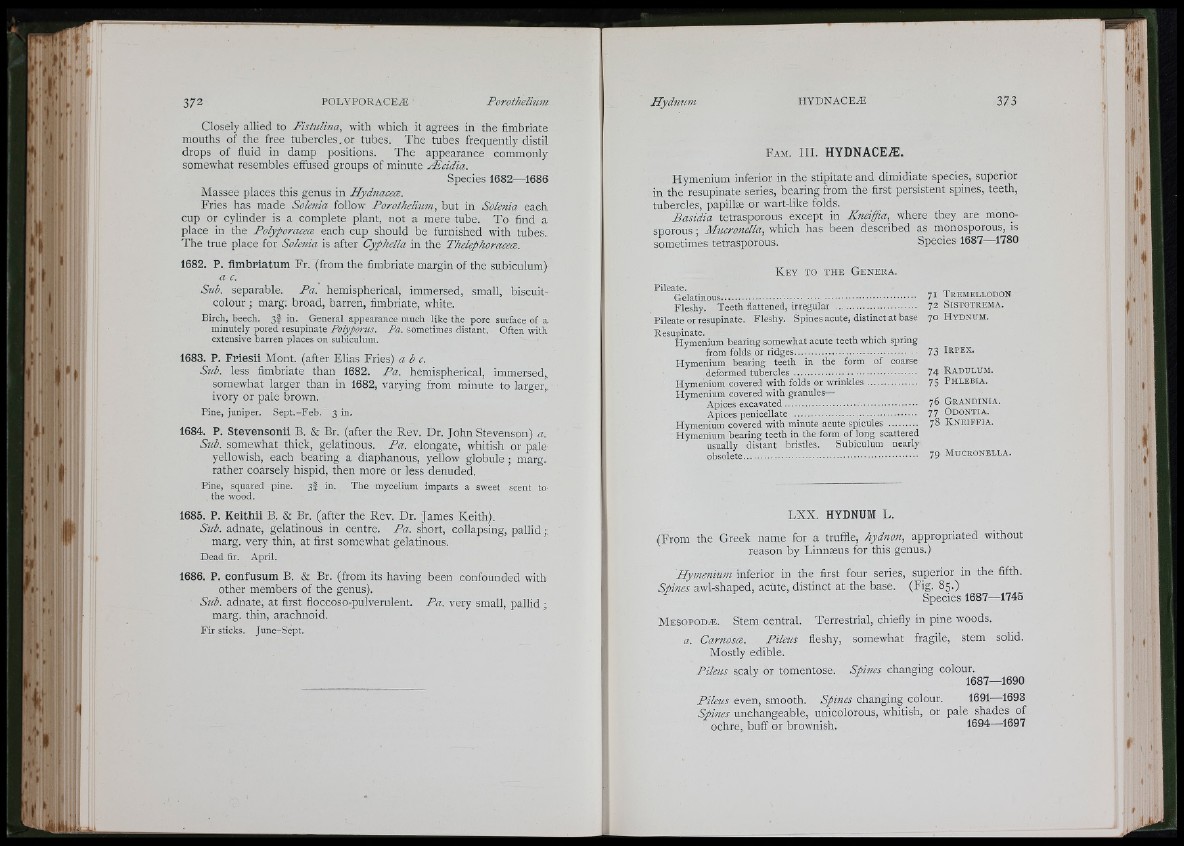
m - -
i ft
i l ] . i
MG
| f
l-lti
Vl
i
ü
I I
li
f
* I
9 ;
fl ■
' ' I
( ;
Q:
■ i !
Closely allied to Fistulina, with which it agrees in the fimbriate
mouths of the free tubercles.or tubes. The tubes frequently distil
drops of fluid in damp positions. The appearance commonly
somewhat resembles eflused groups of minute Æcidia.
Species 1682— 1686
Massee places this genus in Piydnaceoe.
Fries has made Solenia follow Porotheliuin, but in Solenia each
cup or cylinder is a complete plant, not a mere tube. To find a
place in the Polyporaceoe each cup should be furnished with tubes.
The true place for Solenia is after Cyphella in the Thelephoraceæ.
1682. P. flmbriatum Fr. (from the fimbriate margin of the subiculum)
a c.
Sub. separable. Pa. hemispherical, immersed, small, biscuit-
colour ; marg: broad, barren, fimbriate, white.
Birch, beech. 3J in. General appearance much like the pore surface of a
minutely pored resupinate Polyporus. Pa. sometimes distant. Often with
extensive barren places on subiculum.
1683. P. Friesii Mont. (after Elias Fries) abc.
Sub. less fimbriate than 1682. Pa. hemispherical, immersed,,
somewhat larger than in 1682, varying from minute to larger,,
ivory or pale brown.
Pine, juniper. Sept.-Feb. 3 in.
1684. P. Stevensonii B. & Br. (after the Rev. Dr. John Stevenson) a.
Sub. somewhat thick, gelatinous. Pa. elongate, whitish or pale
yellowish, each bearing a diaphanous, yellow globule ; marg.
rather coarsely hispid, then more or less denuded.
Pine, squared pine. 3I in. The mycelium imparts a sweet scent to
the wood.
1685. P. Keithii B. & Br. (after the Rev. Dr. James Keith).
Sub. adnate, gelatinous in centre. Pa. short, collapsing, pallid
marg. very thin, at first somewhat gelatinous.
Dead fir. April.
1686. P. eonfusum B. & Br. (from its having been confounded with
other members of the genus).
Sub. adnate, at first floccoso-pulverulent. Pa. very small, pallid ;
marg. thin, arachnoid.
Fir sticks. June-Sept.
'I A
lil l ' 1
, M :
r*:
F am . III. HYDNACEÆ.
Hymenium inferior in the stipitate and dimidiate species, superior
in the resupinate series, bearing from the first persistent spines, teeth,
tubercles, papillæ or wart-like folds.
Basidia tetrasporous except in Kneiffia, where they are mono-
sporous ; Mucronella, which has been described as monosporous, is
sometimes tetrasporous. Species 1687— 1780
K e y t o t h e G e n e r a .
Gdatinous........................................................................................ P T r em e llo d o n
Fleshy. Teeth flattened, irregular ...................................... 72 Sistotrema.
Pileate or resupinate. Fleshy. Spines acute, distinct at base 70 H ydnum.
Resupinate.
Hymenium bearing somewhat acute teeth which spring
from folds or ridges........................................................ 73 IRPEX.
Hymenium bearing teeth in the form of coarse
deformed tubercles ........................................................ 74 R adulum.
Hymenium covered with folds or wrinkles........................ 75 P h le b ia .
Hymenium covered with granules—
Apices excavated............................................................. 76 Grandinia.
Apices penicellate ........................................................ 77 O d o n tia .
Hymenium covered with minute acute spicules ............... 78 Kneiff ia .
Hymenium bearing teeth in the form of long scattered
usually distant bristles. Subiculum nearly
obsolete.............................................................................. 79 M u c r o n e l l a .
I'
LXX. HYDNUM L.
(From the Greek name for a truffle, hydnon, appropriated without
reason by Linnæus for this genus.)
Hymenium inferior in the first four series, superior in the fifth.
‘ tes awl-shaped, acute, distinct at the base. (Fig. 85.)
Species 1687—1745
M e s o p o d æ . Stem central. Terrestrial, chiefly in pine woods.
a. Carnosa. Pileus fleshy, somewhat fragile, stem solid.
Mostly edible.
Pileus scaly or tomentose. Spines changing colour.
1687—1690
Pileus even, smooth. Sp>ines changing colour. 1691 1693
Spines unchangeable, unicolorous, whitish, or pale shades of
ochre, buff or brownish. 1594—1697